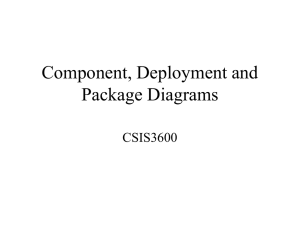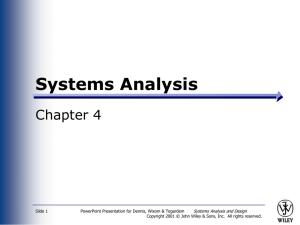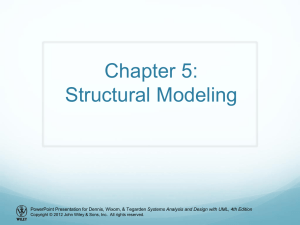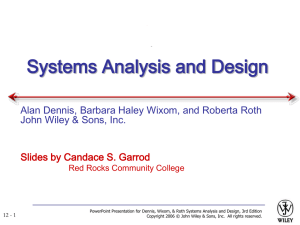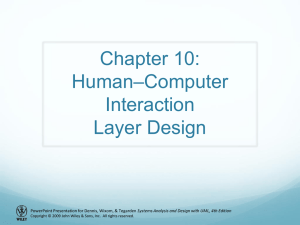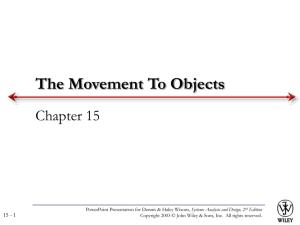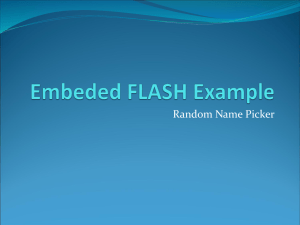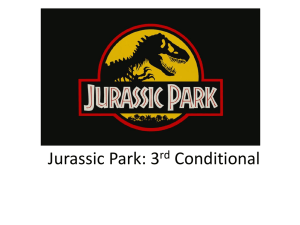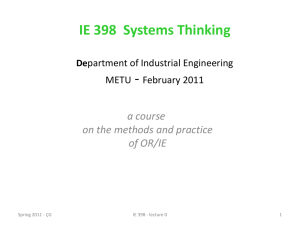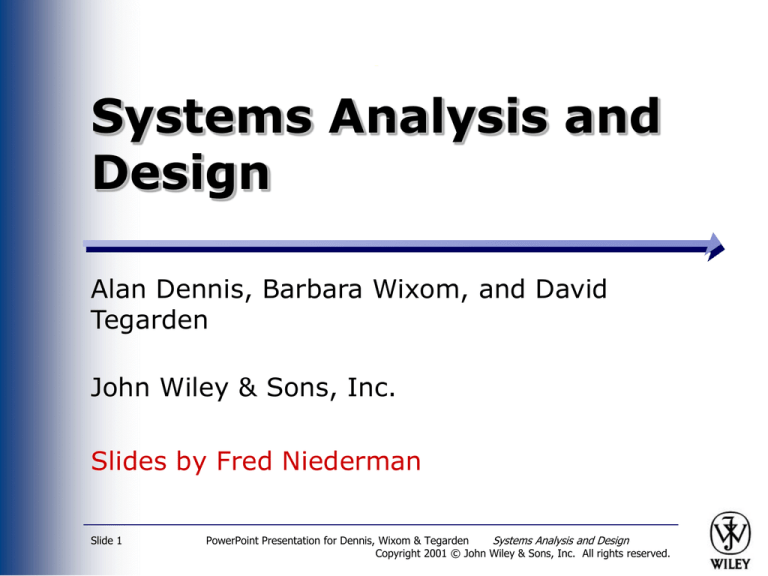
Systems Analysis and
Design
Alan Dennis, Barbara Wixom, and David
Tegarden
John Wiley & Sons, Inc.
Slides by Fred Niederman
Slide 1
PowerPoint Presentation for Dennis, Wixom & Tegarden
Systems Analysis and Design
Copyright 2001 © John Wiley & Sons, Inc. All rights reserved.
Copyright © 2001
John Wiley & Sons, Inc.
All rights reserved. Reproduction or translation of this
work beyond that permitted in Section 117 of the 1976
United States Copyright Act without the express written
permission of the copyright owner is unlawful.
Request for further information should be addressed to
the Permissions Department, John Wiley & Sons, Inc.
The purchaser may make back-up copies for his/her own
use only and not for redistribution or resale.
The Publisher assumes no responsibility for errors,
omissions, or damages, caused by the use of these
programs or from the use of the information contained
herein.
Slide 2
PowerPoint Presentation for Dennis, Wixom & Tegardem
Systems Analysis and Design
Copyright 2001 © John Wiley & Sons, Inc. All rights reserved.
Object Persistence Design
Chapter 13
Slide 3
PowerPoint Presentation for Dennis, Wixom & Tegarden
Systems Analysis and Design
Copyright 2001 © John Wiley & Sons, Inc. All rights reserved.
Key Definitions
Object persistence involves the
selection of a storage format
and optimization for
performance.
Four basic formats used for
object persistence are: files, OO
databases, object-relational,
and relational databases.
Slide 4
PowerPoint Presentation for Dennis, Wixom & Tegardem
Systems Analysis and Design
Copyright 2001 © John Wiley & Sons, Inc. All rights reserved.
OBJECT PERSISTENCE
FORMATS
Slide 5
PowerPoint Presentation for Dennis, Wixom & Tegarden
Systems Analysis and Design
Copyright 2001 © John Wiley & Sons, Inc. All rights reserved.
Files
Sequential Access
Data stored in order based on a
particular attribute
Typically efficient for reports using all
or most of the file’s data
Random Access
Data stored in unordered fashion
Typically efficient for finding individual
records
Slide 6
PowerPoint Presentation for Dennis, Wixom & Tegardem
Systems Analysis and Design
Copyright 2001 © John Wiley & Sons, Inc. All rights reserved.
Types of Files
Master files – store core data
Look-up files – reference information
tat is used during validation
processing (valid codes, etc)
Transaction files – temporary files of
data that will update a master file
Audit files – trace changes made to
files
History files – contain archived data
Slide 7
PowerPoint Presentation for Dennis, Wixom & Tegardem
Systems Analysis and Design
Copyright 2001 © John Wiley & Sons, Inc. All rights reserved.
Relational Databases
Primary key
Foreign key
Referential integrity
Structured Query Language (SQL)
Tables
Joining tables
Objects must be converted so they
can be stored in a table
Slide 8
PowerPoint Presentation for Dennis, Wixom & Tegardem
Systems Analysis and Design
Copyright 2001 © John Wiley & Sons, Inc. All rights reserved.
Customer Order File
Figure 13-1 Goes Here
Slide 9
PowerPoint Presentation for Dennis, Wixom & Tegardem
Systems Analysis and Design
Copyright 2001 © John Wiley & Sons, Inc. All rights reserved.
Object-Relational Databases
Relational databases extended to
handle the storage of objects
Use of user-defined data types
Extended SQL
Inheritance tends to be language
dependent
Slide 10
PowerPoint Presentation for Dennis, Wixom & Tegardem
Systems Analysis and Design
Copyright 2001 © John Wiley & Sons, Inc. All rights reserved.
Relational Database Example
Figure 13-3 Goes Here
Slide 11
PowerPoint Presentation for Dennis, Wixom & Tegardem
Systems Analysis and Design
Copyright 2001 © John Wiley & Sons, Inc. All rights reserved.
Object-Oriented Databases
Two approaches
Adding persistence extensions to OO
languages
Separate database management systems
Extents
Object ID assigned
Some inheritance
Repeating groups or multivalued attributes
Mainly support multimedia applications
Sharp learning curve
Slide 12
PowerPoint Presentation for Dennis, Wixom & Tegardem
Systems Analysis and Design
Copyright 2001 © John Wiley & Sons, Inc. All rights reserved.
Selecting an Object
Persistence Format
Slide 13
PowerPoint Presentation for Dennis, Wixom & Tegardem
Systems Analysis and Design
Copyright 2001 © John Wiley & Sons, Inc. All rights reserved.
MAPPING PROBLEM DOMAIN
OBJECTS TO OBJECT
PERSISTENCE FORMATS
Slide 14
PowerPoint Presentation for Dennis, Wixom & Tegarden
Systems Analysis and Design
Copyright 2001 © John Wiley & Sons, Inc. All rights reserved.
The Process of Analysis
Identify a problem
Analyze the problem
The conceptualization is of the
problem domain
Analysis becomes models
Models are iterated into the
system design
Slide 15
PowerPoint Presentation for Dennis, Wixom & Tegardem
Systems Analysis and Design
Copyright 2001 © John Wiley & Sons, Inc. All rights reserved.
Process of Design
Design strives to map the
problem domain to the
technological solution
In UML, classes build the
foundation
Slide 16
PowerPoint Presentation for Dennis, Wixom & Tegardem
Systems Analysis and Design
Copyright 2001 © John Wiley & Sons, Inc. All rights reserved.
Example Class Diagram
Slide 17
PowerPoint Presentation for Dennis, Wixom & Tegardem
Systems Analysis and Design
Copyright 2001 © John Wiley & Sons, Inc. All rights reserved.
Slide 19
PowerPoint Presentation for Dennis, Wixom & Tegardem
Systems Analysis and Design
Copyright 2001 © John Wiley & Sons, Inc. All rights reserved.
Problem Domain to
Design
How do you move from the
problem domain to the design
of the technology?
Recognize that other classes are
needed to facilitate
implementation of the design
Slide 20
PowerPoint Presentation for Dennis, Wixom & Tegardem
Systems Analysis and Design
Copyright 2001 © John Wiley & Sons, Inc. All rights reserved.
Layers of Classes
FOUNDATION
typically available with
development language
SYSTEM ARCHITECTURE
how the software will
execute
HUMAN-COMPUTER INTERACTION
User interface
(web pages for example)
DATA MANAGEMENT
deals with persistence
how objects will be
stored and retrieved
PROBLEM DOMAIN
environment view
Slide 21
PowerPoint Presentation for Dennis, Wixom & Tegardem
Systems Analysis and Design
Copyright 2001 © John Wiley & Sons, Inc. All rights reserved.
Mapping for Persistence
Focus is on identifying what
must be persisted (stored, etc).
Mapping those classes from the
problem domain to the data
management domain
Slide 22
PowerPoint Presentation for Dennis, Wixom & Tegardem
Systems Analysis and Design
Copyright 2001 © John Wiley & Sons, Inc. All rights reserved.
Initial Points to Consider
Adding primary and foreign keys
Unless they add too much
overhead
Data management functionality only
in classes at data management
layer
May add overhead, but aids in
portability and reuse
Slide 23
PowerPoint Presentation for Dennis, Wixom & Tegardem
Systems Analysis and Design
Copyright 2001 © John Wiley & Sons, Inc. All rights reserved.
Appointment System Problem
Domain and Data Management
Layers
Slide 24
PowerPoint Presentation for Dennis, Wixom & Tegardem
Systems Analysis and Design
Copyright 2001 © John Wiley & Sons, Inc. All rights reserved.
Factoring Out Multiple Inheritance
Effect
Add attribute of Object Id
for subclass
Copy attributes and
methods of ‘extra’
subclass to all data
management subclasses
Slide 25
PowerPoint Presentation for Dennis, Wixom & Tegardem
Systems Analysis and Design
Copyright 2001 © John Wiley & Sons, Inc. All rights reserved.
Mapping Problem Domain Objects to
ORDBMS Schema
Problem domain classes are
mapped to data management
classes and then to database
tables
Slide 26
PowerPoint Presentation for Dennis, Wixom & Tegardem
Systems Analysis and Design
Copyright 2001 © John Wiley & Sons, Inc. All rights reserved.
Mapping Problem Domain Objects to
ORDBMS Schema -- Example
Slide 27
PowerPoint Presentation for Dennis, Wixom & Tegardem
Systems Analysis and Design
Copyright 2001 © John Wiley & Sons, Inc. All rights reserved.
Mapping to OORDMS
Handling attributes
Map single-valued attributes to
Columns in the table
Set of access methods in the data
management class
Slide 28
PowerPoint Presentation for Dennis, Wixom & Tegardem
Systems Analysis and Design
Copyright 2001 © John Wiley & Sons, Inc. All rights reserved.
Mapping to OORDMS
Handling Methods
Methods (and derived
attributes) can be mapped to
stored procedures or problem
modules
Slide 29
PowerPoint Presentation for Dennis, Wixom & Tegardem
Systems Analysis and Design
Copyright 2001 © John Wiley & Sons, Inc. All rights reserved.
Mapping to OORDMS
Handling Relationships
Map simple relationships and
aggregation to a column that
stores an Object ID (ie similar
to a foreign key)
Slide 30
PowerPoint Presentation for Dennis, Wixom & Tegardem
Systems Analysis and Design
Copyright 2001 © John Wiley & Sons, Inc. All rights reserved.
Mapping to OORDMS
Other major steps
Multi-valued attributes are mapped
to columns that contain a set of
values
Repeating groups of attributes can
be used to create a new table
Map many-to-many using a
combination of the 2 steps above
Deal with generalization and
inheritance
Slide 31
PowerPoint Presentation for Dennis, Wixom & Tegardem
Systems Analysis and Design
Copyright 2001 © John Wiley & Sons, Inc. All rights reserved.
Mapping Problem Domain Objects to
ORDBMS Schema -- Rules
Slide 32
PowerPoint Presentation for Dennis, Wixom & Tegardem
Systems Analysis and Design
Copyright 2001 © John Wiley & Sons, Inc. All rights reserved.
Mapping Problem Domain Objects to
RDBMS Schema
Problem domain classes are
mapped to data management
classes and then to database
tables
(same as OORDBMS)
Slide 33
PowerPoint Presentation for Dennis, Wixom & Tegardem
Systems Analysis and Design
Copyright 2001 © John Wiley & Sons, Inc. All rights reserved.
Mapping Problem Domain Objects to
RDBMS Schema -
Map single-valued attributes to
Columns in the table
Set of access methods in the data
management class
Methods (and derived
attributes) can be mapped to
stored procedures or problem
modules
Slide 34
PowerPoint Presentation for Dennis, Wixom & Tegardem
Systems Analysis and Design
Copyright 2001 © John Wiley & Sons, Inc. All rights reserved.
Mapping to RDMS
Handling Relationships
Map simple relationships and
aggregation to a column that
stores a foreign key for the
related tables
Slide 35
PowerPoint Presentation for Dennis, Wixom & Tegardem
Systems Analysis and Design
Copyright 2001 © John Wiley & Sons, Inc. All rights reserved.
Mapping to RDMS
Other major steps
Multi-valued attributes are mapped
to new tables
Repeating groups of attributes can
be used to create a new table and
often a new problem domain class
Map many-to-many to a new table
that relates the 2 original tables
Deal with generalization and
inheritance
Slide 36
PowerPoint Presentation for Dennis, Wixom & Tegardem
Systems Analysis and Design
Copyright 2001 © John Wiley & Sons, Inc. All rights reserved.
Mapping Problem Domain Objects to
RDBMS Schema -- Rules
Slide 37
PowerPoint Presentation for Dennis, Wixom & Tegardem
Systems Analysis and Design
Copyright 2001 © John Wiley & Sons, Inc. All rights reserved.
Which to use?
Generic customer information?
Pictures, video segments, etc?
Temporary data?
Data needed to process a web page
that you do not want to store on the
server?
Slide 38
PowerPoint Presentation for Dennis, Wixom & Tegardem
Systems Analysis and Design
Copyright 2001 © John Wiley & Sons, Inc. All rights reserved.
PowerPoint Presentation for Dennis, Wixom & Tegardem
Systems Analysis and Design
Copyright 2001 © John Wiley & Sons, Inc. All rights reserved.
OPTIMIZING RDBMS-BASED
OBJECT STORAGE
Slide 40
PowerPoint Presentation for Dennis, Wixom & Tegarden
Systems Analysis and Design
Copyright 2001 © John Wiley & Sons, Inc. All rights reserved.
Dimensions of Data
Storage Optimization
Storage efficiency (minimizing
storage space)
Speed of access (minimizing
time to retrieve desired
information)
Slide 41
PowerPoint Presentation for Dennis, Wixom & Tegardem
Systems Analysis and Design
Copyright 2001 © John Wiley & Sons, Inc. All rights reserved.
Optimizing Storage Efficiency
Reduce redundant data
Limit null values
Multiple possible interpretations
can lead to mistakes
A well-formed logical data model
does not contain redundancy or
many null values
Slide 42
PowerPoint Presentation for Dennis, Wixom & Tegardem
Systems Analysis and Design
Copyright 2001 © John Wiley & Sons, Inc. All rights reserved.
The Steps of Normalization
Slide 43
PowerPoint Presentation for Dennis, Wixom & Tegardem
Systems Analysis and Design
Copyright 2001 © John Wiley & Sons, Inc. All rights reserved.
Optimizing Access Speed
Denormalization
Clustering
Intra-file
Inter-file
Indexing
Slide 44
PowerPoint Presentation for Dennis, Wixom & Tegardem
Systems Analysis and Design
Copyright 2001 © John Wiley & Sons, Inc. All rights reserved.
Payment Type Index
Slide 45
PowerPoint Presentation for Dennis, Wixom & Tegardem
Systems Analysis and Design
Copyright 2001 © John Wiley & Sons, Inc. All rights reserved.
Guidelines for Creating
Indexes
Use indexes sparingly for transaction
systems
Use many indexes to increase response
times in decision support systems
For each table
Create a unique index based on the primary
key
Create an index based on the foreign key
Create an index for fields used frequently for
grouping, sorting, or criteria
Slide 46
PowerPoint Presentation for Dennis, Wixom & Tegardem
Systems Analysis and Design
Copyright 2001 © John Wiley & Sons, Inc. All rights reserved.
Steps for Estimating Size
of a DB
Calculate raw data needs
Calculate overhead as
percentage of each record
1.
2.
Past experience, vendor
recommendations, etc.
1.
3.
Record number of records to
be initially loaded and
expected monthly growth
Slide 47
PowerPoint Presentation for Dennis, Wixom & Tegardem
Systems Analysis and Design
Copyright 2001 © John Wiley & Sons, Inc. All rights reserved.
Estimating Data Storage
Size
Field
Average Size (Characters)
Order number
Date
Cust ID
Last name
First name
State
Amount
Tax rate
Record Size
Overhead (30%)
Total Record Size
Slide 48
8
7
4
13
9
2
4
2
49
14.7
63.7
Initial Table Size
Initial Table Volume
Growth/Month
Table volume @
3 years
50,000
3,185,000
1,000
5,478,200
PowerPoint Presentation for Dennis, Wixom & Tegardem
Systems Analysis and Design
Copyright 2001 © John Wiley & Sons, Inc. All rights reserved.
Expanding the Domain
The Object Data Management
Group is working on
standardization of the OO
database features. Check them
out at:
http://www.odmg.org
Slide 49
PowerPoint Presentation for Dennis, Wixom & Tegardem
Systems Analysis and Design
Copyright 2001 © John Wiley & Sons, Inc. All rights reserved.

